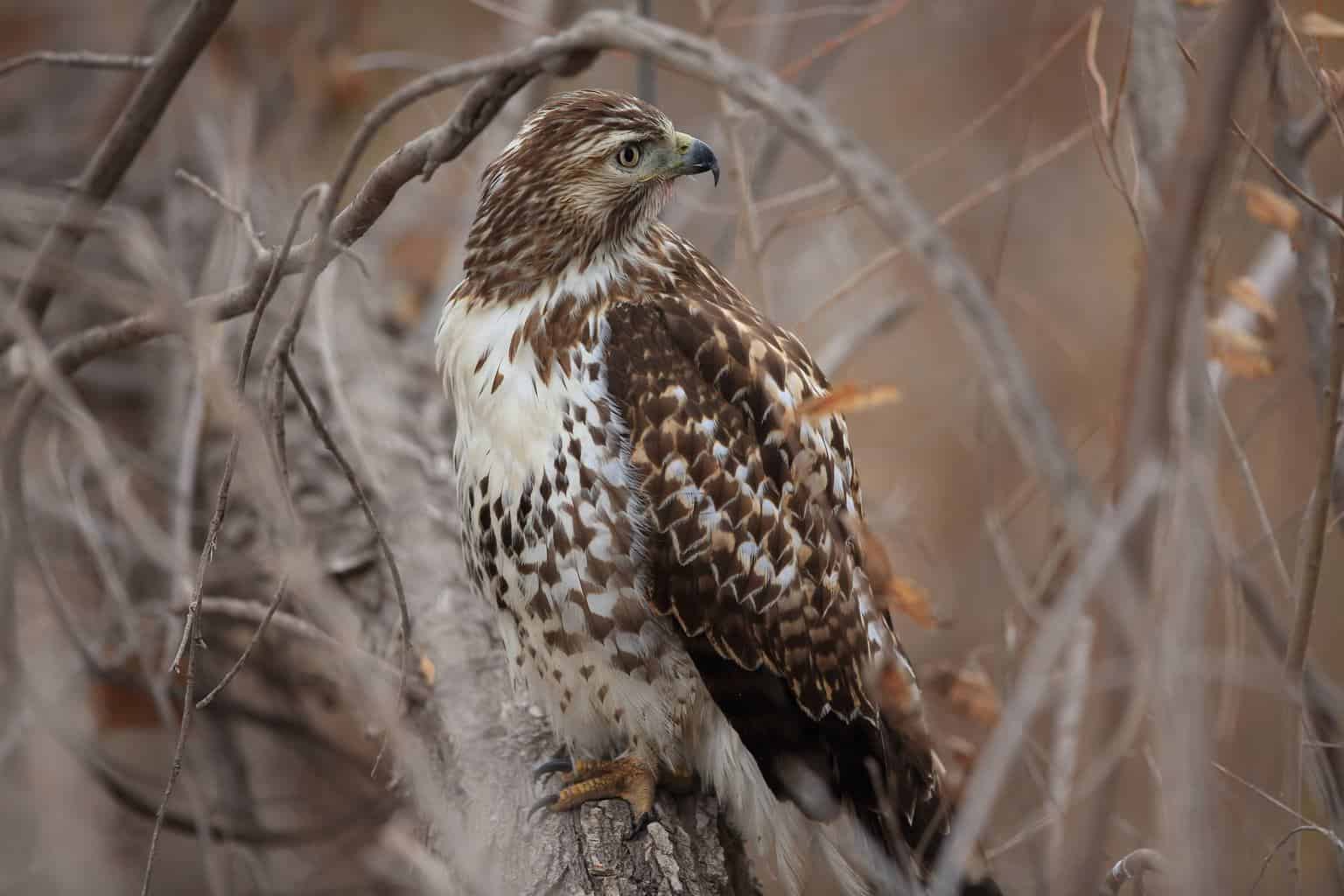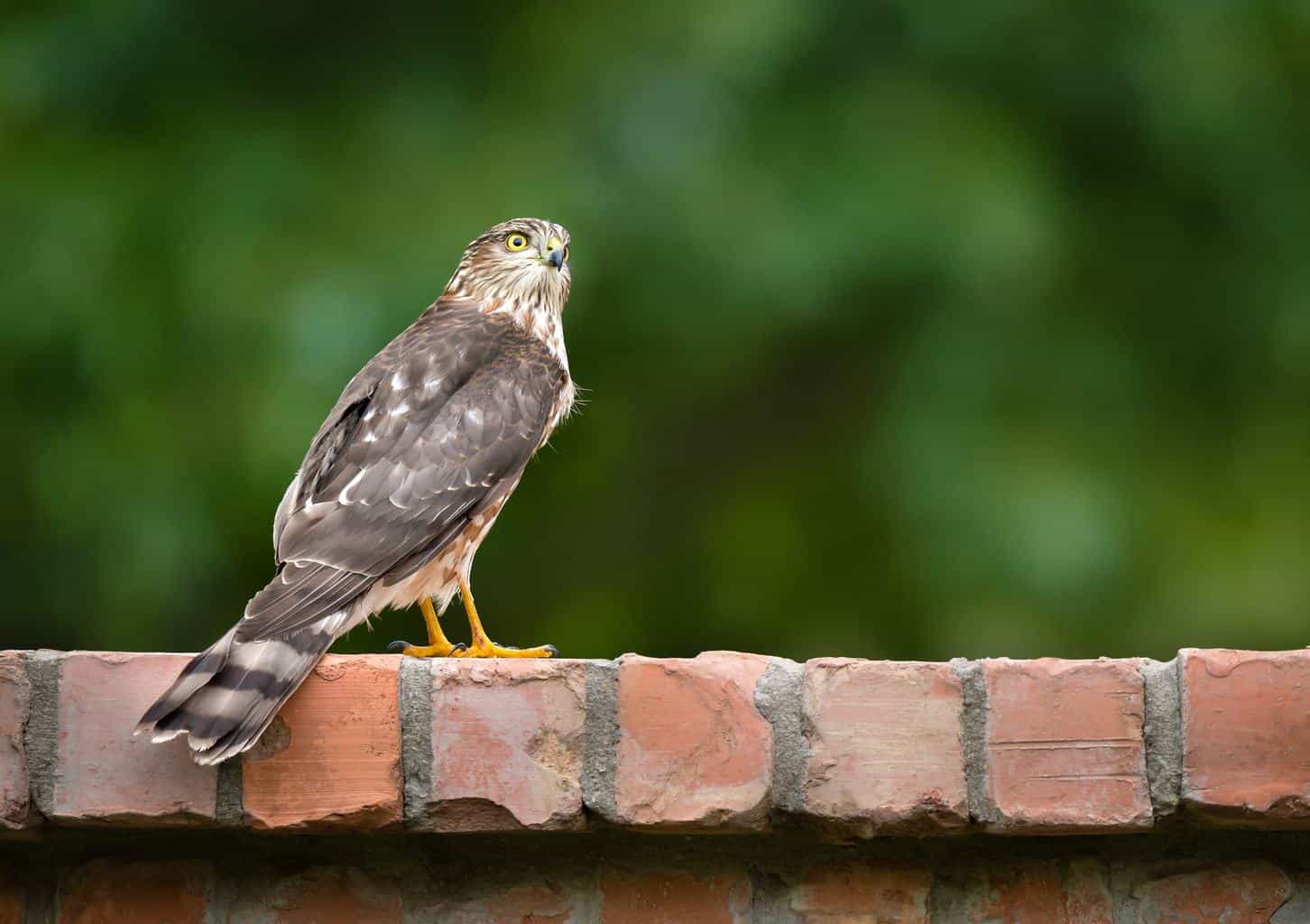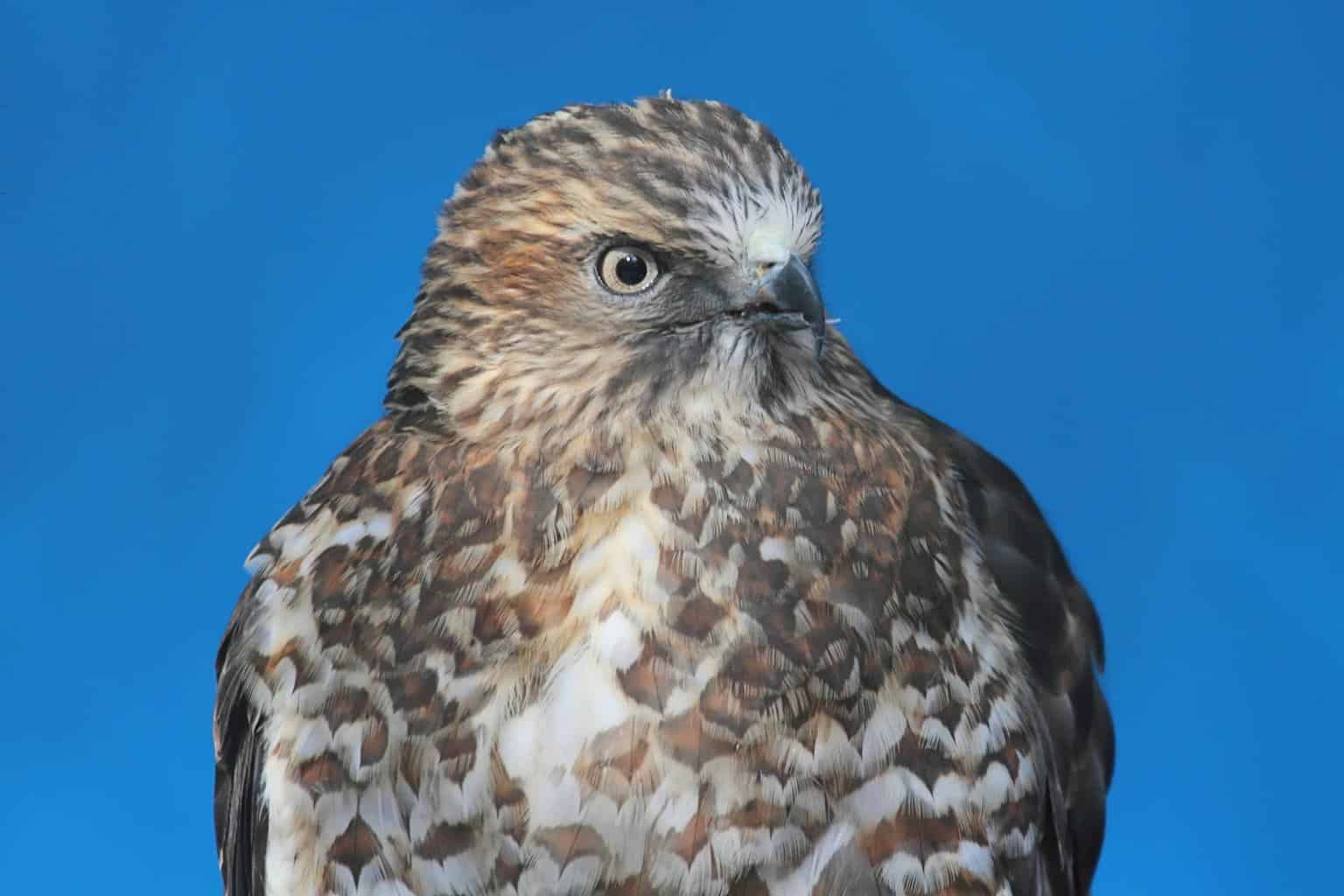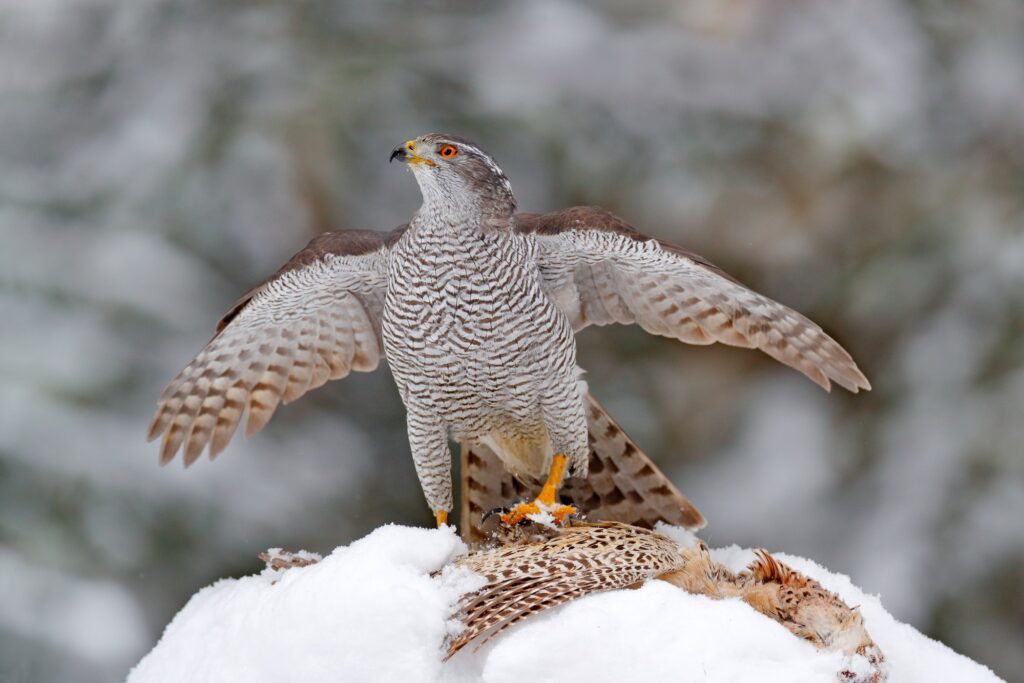Hawks prefer high places to build their nest, places like the side of a cliff or on top of a high tree. So, what are they doing in the Empire State? They don’t build their nests on skyscrapers, do they? Maybe not, but New York is full of places for hawks to live and hunt. From the Hudson River to the Adirondacks, the hawks are living their best life in the state.
Today, we’ll take a closer look at these magnificent hawks in New York.
Red-Tailed Hawk

-
Scientific Name: Buteo jamaicensis
-
Length: 17.7-25.6 inches
-
Weight: 38.8 ounces
-
Wingspan: 40-60 inches
The red-tailed hawk is likely the most widely recognized species of hawk in New York. If you have sharp eyes, you’ll see a few of them when you go out for a long car ride, as red-tailed hawks are typically found on top of fence posts, telephone poles, or edges of fields.
These huge hawks are wide and short with rounded wings and a wide tail. Most of these feathered creatures have a chocolate brown color on their backs. They additionally have a pale tone underneath, with a striped tummy and a barred underside of the wings. They also have a black bar along the scapula and carpus.
Their tail is generally pale underneath and cinnamon-red above, which is what gives this species its name. They go after little mammals such as bunnies, chipmunks, mice, smaller birds, and rodents like voles.
Cooper’s Hawk

-
Scientific Name: Accipiter cooperii
-
Length: 13.7-19.7 inches
-
Weight: 18.7 ounces
-
Wingspan: 29.5-37 inches
Cooper’s hawk is one of the special concern species and greatest conservation need in New York State. The name of this species was picked to honor the naturalist William Cooper, one of the New York Lyceum of Natural History founders.
This hawk has rounded wings, and it looks like a crow with a long black or brown-banded tail. The tail’s end is rounded with a hooked bill. Adult Cooper’s hawks are mainly brownish-gray above and rusty brown colored underneath. When they call out, it sounds like a rapid “ca-ca-ca” sound with a harsh staccato quality.
Their natural habitat is mostly on mixed forests and timberlands. They’re also commonly found in riparian woodlands and woodlots, but they’re also used to human disturbance and habitat fragmentation.
The Cooper’s hawk principally eats medium-sized feathered creatures, like northern flickers, blue jays, mourning doves, European starlings, and ruffed grouse.
Red-Shouldered Hawk

-
Scientific Name: Buteo lineatus
-
Length: 16.9-24 inches
-
Weight: 21.5 ounces
-
Wingspan: 36.20-42 inches
In western and central New York, the red-shouldered hawk was once very common. But, lately, these hawks in New York have declined. In the mid-1900s, around 75 percent of the state was open for farming. Today, 61 percent is forested. While this gives more potential to red-shouldered hawks to inhabit, not the entirety of this land might be suitable for them.
The red-shouldered hawk has black and white checkered wings and a warm red tone on the chest. Their tails are dark with narrow white bands. Additionally, all ages show narrow, pale crescents close to the wingtips while they soar.
Red-shouldered hawks are found soaring over forests on tree branches, woodlands, utility wires, and often swamps and rivers. Their call sounds like a whistled “kee-rah,” which is a distinct sound in the forest. They hunt small amphibians, mammals, and reptiles either while sitting on a pole or branch or while flying.
Northern Harrier

-
Scientific Name: Circus cyaneus
-
Length: 16-20 inches
-
Weight: 10-26 ounces
-
Wingspan: 38-48 inches
Unlike other hawks, the northern harrier’s sense of hearing is very sharp, helping them find their prey easier. Northern harriers have an owl-like facial circle to assist with directional hearing, and they have soft feathers to give them a quieter flight. These characteristics make birds of this species superior hunters.
They plunge onto clueless prey on the ground. This includes rodents, small birds, insects, reptiles, frogs, or occasionally, carcasses of dead animals. In metropolitan territories particularly, this bird helps control mice, rats, and little rodents.
In New York City and New Jersey, these birds can be found all year long, particularly where natural surroundings are reasonable, and prey (generally rodents) is plentiful. They incline toward open space, like the salty river estuaries or in grasslands, woodlands, pastures, and meadows.
Sharp-Shinned Hawk

-
Scientific Name: Accipiter striatus
-
Length: 9-14.6 inches
-
Weight: 2.9- 7.75 ounces
-
Wingspan: 16.5-26.7 inches
The sharp-shinned hawk is the smallest hawk found in New York and North America as a whole. The sharp shin gets its name from the presence of sharp talons and long legs.
Adults of this species have a gray-blue upperpart and a white underpart with reddish-brown stripes. They also have whitish throats, a dark and light-gray striped tail, and red or orange eyes. The eyes of the sharp-shinned birds darken from yellow to orange to red once they reach adulthood.
The majority of the time, the sharp-shinned hawk eats other birds. Feathered creatures the size of warblers, thrushes, or American robins are the birds’ most frequent prey. They’ll also eat little rodents, like mice and voles, and sometimes grasshoppers and moths. During nesting, a large portion of the food they give to their babies comes from other fledglings or nestlings.
Broad-Winged Hawk

-
Scientific Name: Buteo platypterus
-
Length: 13-17 inches
-
Weight: 15.8 ounces
-
Wingspan: 31-40 inches
Broad-winged hawks are little with stout and chunky bodies and big heads. While flying, their broad wings look like a distinct point, and their tail is square and short.
These hawks hunt small animals from underneath twigs and branches. They are usually found in roadcuts or in places that have high points, and their call sounds like a puncturing whistle on a single pitch.
During fall migration, there are a few areas just a short drive away from New York City where you can see them taking off along coastlines and mountain ranges, frequently in large flocks. Hook Mountain is one of those spots that are perfect for seeing these small feathered creatures.
Rough-Legged Hawk

-
Scientific Name: Buteo lagopus
-
Length: 18 to 23 inches
-
Weight: 6.7 ounces
-
Wingspan: 52.7 inches
This lovely winged creature, the rough-legged hawk, spends its summers in the arctic tundra. Though they breed there, they’ll relocate to southern Canada and the northern United States, including New York State, during the winter.
You may see them hovering high above or sitting at the highest point on a tree, checking an open green field for some food. They use their powerful vision to spot little warm-blooded animals like mice and voles far underneath in grassy fields. At that point, they dive down to get the food using their claws. They like to chase open wetlands, farmland, and grasslands.
If you gaze upward, you’ll see one or two of these high flyers during wintertime. A few characteristics to look for while trying to identify rough-legged hawks are the dim patches at the side of the wing, a black belly band, and a white bib around the throat.
Northern Goshawk

-
Scientific Name: Accipiter gentilis
-
Length: 20.9 to 25.2 inches
-
Weight: 22.3 to 48.1 ounces
-
Wingspan: 40.5 to 46.1 inches
During the 1960s and 1970s, the northern goshawk settled in northwestern New Jersey, Pennsylvania, New York, and Connecticut.
Northern goshawks are huge hawks and the biggest and bulkiest of the accipiters. They have wide, rounded wings and long tails. Their moderately long flight quills look like crescents, and their wingtips look pointed in flight.
Goshawks are subtle hunters that watch for prey from high places and afterward attack with a fast, agile flight, even through thick trees or if obstacles are blocking them. They generally feed on crows and grouse, but they’ll also eat squirrels, snowshoe hares, snakes, insects, and rabbits.
Conclusion
New York is known for its delicious hotdogs and the Statue of Liberty. What we often forget is that it’s also the home to a lot of bird species like owls, woodpeckers, and hawks.
You may stumble across most of these brilliant hawks during a stroll through Central Park or on a hike in one of New York’s 22 national parks, so keep your trusty binoculars handy just in case.
Are you interested to know more about the other birds you might spot in this state? Check out our list of woodpeckers you can find in New York!

